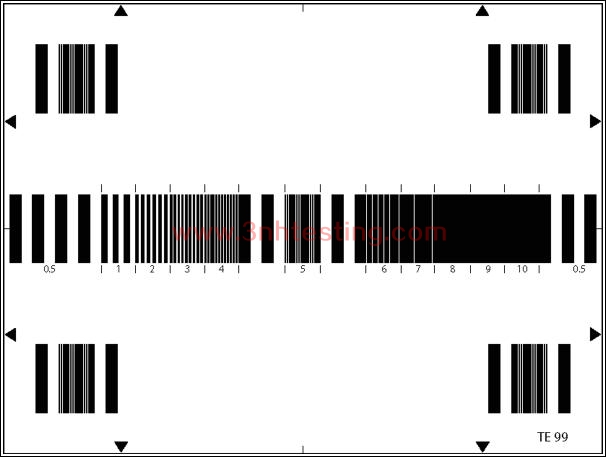HIGH - CLASS IN MEGA CYCLE TEST CHART
- Introduction
- Product Software
HIGH - CLASS IN MEGA CYCLE TEST CHART
REFLECTANCE
.jpg)
A line raster is arranged in the center of the test chart which produces frequencies of 0.5 to 10 MHz
in the output of the TV camera. 0.5 MHz line pairs are also arranged at the center of the line raster
immediately adjacent to the 5 MHz line pairs. Bar rasters are located in the corners of the test charts
and produce frequencies of 0.5 and 5 MHz.
The frequency response of modulation depth and the uniformity of modulation depth can be established
with the aid of line rasters. The signal amplitude of the 0.5 MHz rasters is the reference value.
Measuring equipment:Video oscilloscope or preferably video oscilloscope with memory.
Measurement conditions:The camera settings must be as follows:
Shading correction: ON
Aperture correction: OFF
Gamma correction: OFF
Contour correction: OFF
Color correction:OFF
Iris: F/5.6 for 2/3 “ CCD
F/4for ½“ CCD
The test chart is evenly illuminated so that for the low frequency burst at 0.5 MHz the amplitude of
the video signal at the output of the correctly positioned and focused camera is 0% (0V) for the black
bars and 100% (700mV/ 75 Ohms) for the white bars.
Care must be taken to avoid clipping of the signal to be measured at the black and white level.
Measurements can be made on the various camera output signals, but preferably on the Y luminance
signal (or coded Y with perfect B and W balance). The measurement is made at the center of the
image but also on the edges and at the corners so that account is taken of the lateral chromatic
aberration of the lens. The measurements give the contrast loss of the camera response at the value
of 5 MHz. The obtained response is a contrast transfer function (CTF).
The relation to calculate the MTF according to the CTF is:
MTF (N) = π/4[CTF(N)+ 1/3 CTF(3N) - 1/5 CTF(5N)+ 1/7 CTF(7N) -1/9 CTF(9N) + 1/11 CTF(11N) ...]
where N is the spatial frequency of the test chart analyzed; N in TVL/H

In the - probable - case of a beat affecting camera response for a given spatial frequency, and under
certain conditions only, the measured signal reassembles an amplitude-modulated carrier signal, as
shown in the following figure:
The percentage of modulation is then defined by the relation:
% mod = M/X
The interference ripple at this frequency is given by:
p % = m / M
The results of the measurement may be presented in the form of a table representing the various areas
of the image measured.
CTF values at 5 MHz
xxx % xxx % xxx %
xxx % xxx % xxx %
xxx % xxx % xxx %
News
- 2014-06-26 3nh ISO9001 Certificate
- 2014-06-26 3nh Products Have Got CE Certificat ...
- 2014-06-12 Integrating Sphere
- 2017-11-08 Attention before using T90-7 camera ...
- 2014-06-12 Pantone TPX 2012 (175 New Colors)
- 2014-06-12 ISO 12233 RESOLUTION TEST CHART
- 2014-06-12 The Color of Objects
- 2014-06-26 3nh TUV Certificate
.png)



.jpg)
.jpg)
.jpg)
.jpg)

